Remembering Montgomery Clift: The Forgotten Forerunner

Say the name Montgomery Clift to someone under 35 and you will get, at best, blank looks. Invoke a contemporary – Marlon Brando, James Dean, even Paul Newman – and the reaction is likely different. Even if someone isn't familiar with the entire filmography of one of the aforementioned actors, at the very least the name inspires some recognition: maybe a garbled recitation of a classic line ("I coulda been a contender") or a recalled image (an iconic red jacket) or even a charity-raising salad dressing or cookie. But Montgomery Clift has faded from our cultural landscape so completely that even the most enduring images from some of his most important films aren't of him. Take From Here to Eternity, for example: a film remembered more for dramatic kissing in the surf than the conflicted young man who starred in it.
So first the question is: who is Montgomery Clift? Clift was a movie star of the late ‘40s and early ‘50s who blazed brightly in the early part of his career before an inevitable deterioration, considered by those in the know to be one of the greatest actors of all time. Much has been made of the new male American star of the 1950s: a tormented, sensitive, masculine type who wore dirty T-shirts while he raged and cried. It was quite a shift from what came before and has rightly been called explosive; the effects of that new type of star are still being felt now, images echoing over time. And Montgomery Clift was the very first of his kind.
He was also the victim of a traumatic car accident that many claim crushed his spirit as much as his body, leaving him with an altered appearance and sending him into what would later be deemed "the longest suicide in Hollywood history." It's a neat tagline, summing up what Clift's legacy has become: a tragic footnote in the landscape of American cinema, and often little more than that.
Clift's life was tragic. There is no denying that. He was an alcoholic and an addict, he suffered from a myriad of health issues throughout his life, and he was bisexual at a time and place when it would have been impossible to be open about it. He struggled greatly with his personal identity and it's certainly easy to feed that tragedy into the roles he played and allow his personal life to inform what we see on screen. It coalesces to form a single narrative – a neat tagline. But there is always more to the story than that.
Montgomery Clift was born in 1920 to wealthy enough parents, with an older brother, twin sister, and an apparently overbearing mother. He spent a great portion of his childhood traveling abroad and, upon the dissolution of his parents' wealth, came to settle in New York City. This is where he began to work from a very young age, roughly 12 or so, first as a model and then as an actor. He was not a Method actor, though he was an occasional student of the Studio much later in his 20s; the style of acting that Monty developed emerged partially from raw talent and mostly from work in the field. He was on Broadway very young, working with older and more experienced actors and learning all the while. This is where his name began to gain some cache, and soon enough Hollywood came calling.
Monty was famously picky about parts and ultimately only made 17 movies over the course of his life. The first was in 1947, while frenemy Marlon Brando was still gracing the stage in A Streetcar Named Desire, and the last right before Monty's death in 1966. His "long suicide," as it were, is somewhat apparent on screen: the handsome, effervescent presence in his early work gives way to a man greatly dimmed by alcohol – though still receiving accolades despite it.
The holy trinity of Clift, Brando, and Dean is comprised of men defined by physicality and ultimately undone by it: famed for their bodies and how they used them, they all ended their lives physically destroyed. (A fate escaped by Paul Newman, who came to fame in the sunset of the other men's careers.) Compare the upright, almost stately posture of stars of the '30s and '40s like Fred Astaire and Cary Grant to Clift's expressive tenderness and tight control of his body, Brando's prowling, Dean's fidgeting hunch. Sometimes they moved like animals, sometimes like dancers; they invaded the personal space of their scene partners; their pain was writ across their faces; their lines were sometimes lost in mumbling. It felt more real, less performative. These are all things that seem commonplace to modern audiences because it was set in motion by those actors (though it seems unfair to include James Dean's name in the discussion when he was merely aping Clift and Brando for the most part).

So as they set the screen ablaze with an unforeseen physical power and they all ended their lives with ruined bodies. Dean was famously killed in a car accident before his career had truly begun. Brando suffered from eating disorders throughout his life and eventually gained such a vast amount of weight that it made him an unkind punchline. Monty was in an accident too, and though he was already addicted to booze and pills, the pain that resulted from the accident surely compounded his addictions. The story of the accident is told in Monty biographies like an urban legend, everything waiting and leading up the moment when he attempted to guide his car down a dark road in the Hollywood hills after leaving best friend Elizabeth Taylor's house, and wound up wrapping it around a telephone pole.
The friends who found him in the wreck thought he was dead. He broke his nose, shattered both sides of his jaw, knocked out his teeth. Famously, Liz Taylor crawled into the crushed car to cradle him in her arms and found him choking on his teeth, which she removed by reaching into his throat and pulling them out. They're gory details that are told and retold the way gory details often are: with horror, with fascination. This is where his life ended in the cultural psyche. He was never the same again.
But he did live another decade, a slow decline that brought him farther from the public eye the harder he tried to hold on to his career. It seems a waste to dismiss those years purely because they're not glamorous, because his struggle was less easily ignored.
So why has Clift been forgotten? Why is his name only remembered by cinephiles and Hollywood fanatics? Why isn't his face plastered on cheesy posters and H&M T-shirts?

It can't be mere tragedy. All people suffer and Hollywood in particular is famous for making lemonade out of lemons. It could be that his films remain primarily in black and white, his face in a tight close-up; James Dean is the most recognized name in this article and every single one of his films was in color, clearly to his advantage. It's a horrible thought, but had he passed away in his accident like James Dean had, would Clift also be an icon of lost potential, forever held up not for what he did but for what he might, one day, have done? Or is it the question of his sexuality? Dean was also bisexual, but queerness seems to be wrought into the very fabric of Monty's image, leaving him branded Sad, Dead, and Gay without any deeper insight.
It's hard to determine the answer these many years later, when almost all of the old stars have vanished from the cultural landscape except in the most superficial of ways. But it's worth bringing them back up again now and then, revisiting what made them special and what legacy they left behind. Montgomery Clift's fade from our collective consciousness seems especially, poignantly sad when one considers that he was a man who was devoted to his work, a true artist within his particular craft. But there has been talk of an HBO film depicting his life starring Matt Bomer, so there is always hope that Clift's memory might be revived.
Author Bio:
Megan Walsh is a contributing writer at Highbrow Magazine.






























































































































































































































































































































